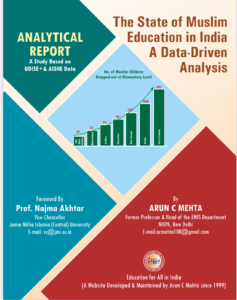Shool Education Indicators in India 2023
Importance of Child Population to Compute Educational Indicators (2023)
Computation of Out-of-School Children Based on Administrative Data (UDISEPlus 2021-22)
Key Findings of Enrolment Ratio at All India Level 2021-22
Samagra Shiksha School Education Indicators
This website section presents Indicators of Educational Development in terms of School Education Samagra Shiksha Indicators in India. Indicators play an essential role in assessing the current status of educational development at different levels, such as school, cluster, block, district, state, and all-India levels. First, let us discusses what we mean by an indicator.
What is an indicator?
To understand what an indicator is? Moreover, for other questions of similar nature, let us first define an indicator. An indicator is that which points out or directs attention to something (Oxford Dictionary). According to Johnston (1981), an indicator should give a broad indication of the state of the situation being investigated. An indicator is not an elementary item of information but is processed information. Indicators are often compared to a ‘norm’ or a ‘standard’ (like pupil-teacher ratio) or a previous score. Indicators reflect how an objective can be achieved and to what degree approximately the objective has been achieved at any stage.
The following are the characteristics of a good indicator:
- An indicator should provide helpful information to the policymakers
- Its ability to summarize information without distortions
- Its precision and comparability
- Its reliability and frequency of updating
- It allows one to relate it with other indicators for global analysis
- It measures how far or how close one is to the objectives
- It helps to identify the problematic or unacceptable situation
- It meets policy concerns; and
- It helps to compare its value to a reference value, to a norm/standard, or to itself, as computed for different periods
Rate & Ratio
Raw data is converted into indicator form using simple statistical tools such as percentage, rate and ratio, and index number. ‘Rate’ indicates the percentage change in the variables over two different periods. It shows the growth or decline in a variable. On the other hand, ‘Ratio’ shows the relationship between two variables at any particular period. Rates and ratios are interchangeable and generally expressed as percentages for straightforward interpretation, whereas ‘Percentage’ is the mathematical relationship between two variables multiplied by 100. Index numbers are calculated to review the progress concerning a particular point in time.
The Present Status of School Education in India: Analysis of the Latest UDISE+ 2021-22 Data
Analysis of Gross Enrollment Ratio 2021-22 (UDISEPlus 2021-22)
Significance of Adjusted Net Enrolment Ratio in Achieving Universal School Education 2023
Enhancing Accessibility for Children with Special Needs: Analysis based on UDISEPlus 2021-22 Data
Impact of School Closures & Mergers on Access to Education in India, 2023
Exploring the Share of OBC Enrollment in India’s School Education System (2023)
Out-of-School children in the Context of School Education in India (2023)
How are indicators developed?
Indicators can be developed in a variety of ways. The most common form of indicator is the representative indicator. It involves the selection of a single variable to reflect some aspect of an educational system. However, it does not justify selecting one variable rather than the other. Therefore, choosing one variable to act as an indicator for an education system is an impossible task and the most unsatisfactory one. That is why some indicators are disaggregated in nature. Instead of only one variable to represent a concept, this type of indicator requires definitions of variables for every element or component of the education system, which is confusing and challenging to manage. The other variety of indicators is a composite indicator that combines several variables. The final composite indicator is interpreted as the average of all variables.
Educational Indicators
In our day-to-day life, we come across various indicators that can be classified into three broad categories: input, process, and output. Some examples of these indicators are various process control machines such as automatic milk booths and automatic weighing machines. However, in the field of education, the classification of indicators under different categories is not an easy task.
Age-Specific Enrolment Ratio (ASER): Bridging the Educational Divide
Generally, we view education as a system, which receives inputs in the form of new entrants, transforms these inputs through certain internal processes, and finally yields specific outputs in the form of graduates. The output from a given education cycle is defined as those students who complete the cycle successfully. The input used in the education processes is measured in terms of student years. Educational indicators can be classified into size or quantity, equity, efficiency, and quality
Status of School Education in view of NER 2021-22
The Highlight of UDISE+ 2021-22 Data at the All India Level
Examining Enrollment Impact: From Primary Education to Higher Education in India – NER Insights 2023
There are four components of universalization, namely universal access, universal participation or enrolment, universal retention, and universal quality of education indicators; each of these components has been presented in this section through a series of articles published from time to time.
Indicators play an essential role in the stock-taking exercise, which is also known as the diagnosis exercise, through which one can know the present status in terms of where a district/state stands so far as the goal of universalization of school education is concerned, which can be divided into a universal primary, the elementary and secondary level of education.
Upskilling in AI, Machine Learning, & Data Science to Grow in Your Career
Role of Arun C Mehta in creating awareness about the use of educational indicators
Prof. Arun C Mehta has worked in NIEPA, a premier institute in educational planning and administration, for almost forty years and contributed significantly towards the development of indicators in terms of their construction, definitions, interpretation, limitations, and implication in plan formulation. He was also part of the EFA Assessment, prepared India Country Report, and represented the country internationally. During his career, Prof. Mehta engaged in data analysis and wrote extensively on indicators and their use in plan formulation.
Retention Rate at School Education Level in India
Share of Muslim Enrolment at School Education in India: 2012-13 to 2021-22
Articles authored by Prof. Mehta on educational indicators are still very much relevant. It is used widely by the district and state-level officers engaged in plan formulation under the banner of DPEP, SSA, and now Samagra Shiksha Samiti. He has also written on the implications of NEP 2020 recommendations on indicators and highlighted the usefulness of reviewing the existing set of indicators and a composite new set of indicators because of the restructuring of the school education structure in the line of recommendations of NEP 2020.
In addition to the formal education system, several indicators for the NFE program were also developed as part of UNESCO and UNICEF initiatives. Arun C Mehta was first exposed to educational indicators and EMIS when he underwent an internship at UNESCO Regional Office in Bangkok.
All his research on the composition of indicators and its analysis and implications in plan formulation has been presented in this part of the website, which the viewers would find useful. His long experience with the field-level functions engaged in DPEP, SSA, RMSA, and Samagra Shiksha Samiti has made him understand the field realities.
The following Article presents a critical analysis of all educational indicators which are required in the efficient formulation of an educational plan at state and district levels, which the users may find useful.
- Indicators of Educational Development: A Core Paper, Concept & Definitions
- From Indicators of Enrolment to Attendance rate
- Indicators of educational development (EFA 18-indicators)
- Indicators of Educational Development: Definitions & Real-Life Data
- Indicators to Monitoring Upper Primary Education Programmes
- Indicators of Educational Development: Concepts and Definitions of a Set of Indicators
- Education For All: EFA 18-Core Indicators
- Computing Uncomputed Indicators (NEP 2020) by Arun C Mehta
- Decoding UDISE+ 2021-22 Enrolment Ratios under Samagra Shiksha by Arun C Mehta
- Disaggregated Target Setting and Decentralized Planning & Role of Indicators
- Mango Project: Guidelines for Data Analysis & Information Use: ACCU, Japan Project
- Meaning of Universalisation & Set of New Indicators (NEP2020)
- Education For All in India with Focus on Elementary Education: Current Status, Recent Initiatives, and Future Prospects, Real Life Data: Statement I
- Education For All in India with Focus on Elementary Education: Current Status, Recent Initiatives, and Future Prospects: Statement II
- Rationale of Net Enrolment Ratio
PDF on Use of Indicators
- Is Fifty Percent Increase in Higher Education Enrolment by 2035 Possible?
- Decoding UDISE+ 2021-22 Enrolment Ratios: Samagra Shiksha
- Computing Un-computed Indicators in Response to NEP 2020
- An Analysis of NSSO 75th Round Survey on Status of School Education in India by Arun C Mehta (Full-Size Article)
- Decoding UDISE+ 2021-22 Enrolment Ratios: Samagra Shiksha
- Does UDISE+ Underestimate Dropout Rates
- Sustainable Development Goal 2020-21 Observations by Arun C Mehta (PDF)
- Download Article Tables (SDG4 Education Analysis by Arun C Mehta)
- Download Full PDF, Analysis of NFHS-5 by Arun C Mehta
- Is the decline in school education in India a cause of concern?
- Is India moving towards the privatization of school education?
- Patterns of Decline in Enrolment & its Implications for Universal Secondary Education in India: An In-depth Analysis of U-DISE 2016-17 Data
- Performance Grading Index (PGI) Comments by Arun C Mehta
- School Dropped-out Children state-wise by Prof. Arun C Mehta (PDF)
- School Education Quality Index: Some Observations
- State-wise School Dropouts between 2020-21 & 2021-22
- Status of School Education in India Tables: 2018-19
- Tables 50% Increase in Higher Education Enrolment by 2035 Arun C Mehta
- Data Limitations in Muslim Edeucation in India (2023)
- Muslim Students Flow Rates at School Level in India: Cohort 2020-21
e-Book
Download e-Book , Forty Year of Arun C Mehta at NIEPA which consists of 27 of his articles on indicators, educational statistics and indicators.



